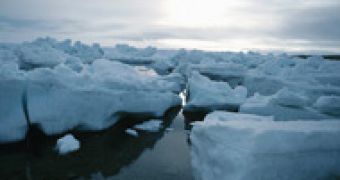According to experts, the longest and deepest ice age known in history, in which the Earth's clime cooled considerably for a few hundred million years, causing the planet to completely freeze over, has been misinterpreted. Actually, the event, which took place in the Neoproterozoic era, from about 850 to 542 million year ago, was stopped by carbon dioxide emissions from volcanoes.
The theory that the Earth might have been completely covered with ice is supported by evidence found in deep ocean sediments, which reveal an abundant quantity of carbon 13 isotope in plant deposits, during the Cryogenian era, while the eras that preceded and followed it, presented lower levels of carbon 13 isotopes. Even so, the carbon 13 levels have been negligible in the Cryogenian era.
The thick ice, which could have reached even the equator, created a bright white shell that reflected the light coming from the Sun, back into space, thus preventing the heating process of the atmosphere and surface. Eventually, 200 million years into the ice age, volcanoes spewed high levels of carbon dioxide into the atmosphere, fact that set the planet on a heating trend which melted the layer of ice.
However, as it was first presented in 1989, this theory is being widely contested, and now, new scenario proposed by a team of physicists, at the University of Toronto, Canada, suggests an alternative solution to the problem. Computer simulations show that as the atmosphere suffers a progressive cooling, the oxygen will sink deep into the sea, where it is dissolved in organic carbon layers which have been created by plant photosynthesis, in carbon dioxide.
During this process, the resulted gas would be released back into the atmosphere, and trigger a greenhouse effect to warm the atmosphere and melt the bodies of ice; this means that the Cryogenian would have suffered a milder cooling, rather that a deep, long freeze.
At the same time, an American geologist contests the assumption that the levels of oxygen in the Cryogenian matched exactly those seen today in Earth's atmosphere, equal to about 21 percent of the total mass of gas. All the evidence points that the oxygen level was extremely low, and it has significantly risen about 550 million years ago, when the fist animals appeared.
This theory could also explain the mystery related to the biodiversity explosion, which took place after the Neoproterozoic, the so-called 'Cambrian Explosion', since a long ice age would have left none or little life, to account for the sudden diversity.
Nevertheless, supporters of the long deep ice age argue that life could survive in extreme conditions, such as the microscopic biota that survived unharmed during the ice age, by populating the pools near the tropics and the thermal vents.

 14 DAY TRIAL //
14 DAY TRIAL //